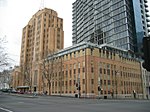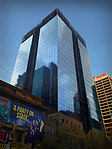Wesley Church, Melbourne
1858 establishments in Australia19th-century Protestant churchesChurches completed in 1858Uniting churches in Melbourne

Wesley Church is a Uniting Church in the centre of Melbourne, in the State of Victoria, Australia. Wesley Church was originally built as the central church of the Wesleyan movement in Victoria. It is named after John Wesley (1703–1791), the founder of Methodism. Today Wesley Church is the home of two Uniting Church congregations, the English-speaking Wesley Church, and the Chinese-speaking Gospel Hall. In 1902, the Wesleyan Church in Australia combined with four other churches to form the Methodist Church of Australasia. In 1977, the Methodist, Presbyterian and Congregational Churches further combined to form the Uniting Church.
Excerpt from the Wikipedia article Wesley Church, Melbourne (License: CC BY-SA 3.0, Authors, Images).Wesley Church, Melbourne
Russell Street, Melbourne Melbourne
Geographical coordinates (GPS) Address Nearby Places Show on map
Geographical coordinates (GPS)
| Latitude | Longitude |
|---|---|
| N -37.810277777778 ° | E 144.96805555556 ° |
Address
Russell Street 248
3000 Melbourne, Melbourne
Victoria, Australia
Open on Google Maps







